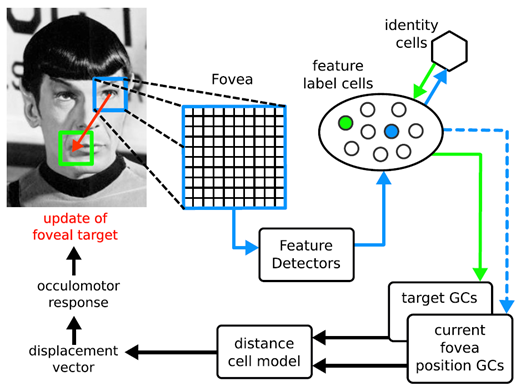
How the brain implements recognition of familiar faces, objects, and scenes at the neural level?
Bicanski and Burgess 2019 propose that grid cells support visual recognition memory, by encoding translation vectors between salient stimulus features. They provide an explicit neural mechanism for the role of directed saccades in hypothesis-driven, constructive perception and recognition, and of the hippocampal formation in relational visual memory.

Pic: Bicanski and Burgess 2019.
Highlights
-
Visual grid cells can encode saccade vectors between salient stimulus features
-
A sequence of (memory-guided) saccades confirms stimulus identity
-
Known properties of grid cells confer size and position invariance onto the model
-
Grid cell lesions may impair relational memory and could contribute to prosopagnosia
For further info, please read the paper Bicanski and Burgess 2019.
Bicanski, Andrej, and Neil Burgess. “A Computational Model of Visual Recognition Memory via Grid Cells.” Current Biology (2019).
About
CogNav Blog
New discovery worth spreading on cognitive navigation in neurorobotics and neuroscience
Recent Posts
- How to build a bio-inspired hardware implementation of an analog spike-based hippocampus memory model?
- How does the brain select what to remember during sleep?
- How hippocampal activity encodes numerous memories of specific events in life?
- How egocentric coding properties arise from its presynaptic inputs, and how egocentric cells represent items across different behavioral contexts?
- How the medial entorhinal cortex develops during learning and influences memory?
Tags
3D Grid Cells
3D Head-Direction Cells
3D Navigation
3D Place Cells
3D Spatial Representation
Allocentric
brain
Brain-inspired Navigation
Brain Navigation
CA1
CAN
Cognitive Map
Cognitive Navigation
compass
Continuous Attractor Neural Network
Direction
Egocentric
Encoding
Episodic Memory
Goal-Directed Navigation
Grid Cell
Grid Cells
head-direction cells
Head Direction
Head Direction Cell
hippocampal
Hippocampus
Indoor Navigation
Insect Navigation
Memory
Navigation
Neural Dynamics
Path Integration
Place Cell
Place Cells
RatSLAM
Representation
Self-Motion
SLAM
Spatial Cognition
spatial memory
Spatial Navigation
Spatial Representation
time
Time Cells
Categories
- 3D Movement
- 3D Navigation
- 3D Path Integration
- 3D Perception
- 3D SLAM
- 3D Spatial Representation
- AI Navigation
- Bio-Inspired Robotics
- Brain-Inspired Navigation
- Cognitive Map
- Cognitive Navigation
- Episodic Memory
- Excerpt Notes
- Flying Vehicle Navigation
- Goal Representation
- Insect Navigation
- Learning to Navigate
- Neural Basis of Navigation
- Path Integration
- Path Planning
- Project
- Research Tips
- Robotic Vision
- Self-Flying Vehicles
- Spatial Cognition
- Spatial Cognitive Computing
- Spatial Coordinate System
- Spatial Memory
- Time
- Unclassified
- Visual Cortex
- Visual Cue Cells
Links
- Laboratory of Nachum Ulanovsky
- Jeffery Lab
- BatLab
- The NeuroBat Lab
- Taube Lab
- Laurens Group
- Romani Lab
- Moser Group
- O’Keefe Group
- DoellerLab
- MilfordRobotics Group
- The Space and Memory group
- Angelaki Lab
- Spatial Cognition Lab
- McNaughton Lab
- Conradt Group
- The Fiete Lab
- The Cacucci Lab
- The Burak Lab
- Knierim Lab
- Clark Spatial Navigation & Memory Lab
- Computational Memory Lab
- The Dombeck Lab
- Zugaro Lab
- Insect Robotics Group
- The Nagel Lab
- Basu Lab
- Spatial Perception and Memory lab
- The Neuroecology lab
- The Nagel Lab
- Neural Modeling and Interface Lab
- Memory and Navigation Circuits Group
- Neural Circuits and Memory Lab
- The lab of Arseny Finkelstein
- The Epstein Lab
- Gu Lab (Spatial Navigation and Memory)
- Fisher Lab (Neural Circuits for Navigation)
- The Alexander Lab (Spatial Cognition and Memory)
- Harvey Lab (Neural Circuits for Navigation)
- Buzsáki Lab
- ……
